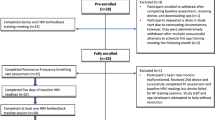Abstract
Biofeedback has been shown to have some level of efficacy for the treatment of a number of chronic medical conditions; however, individualized biofeedback treatment is not always feasible. While group- based interventions are growing in practice due to numerous advantages, the dearth of research examining the efficacy of Group Biofeedback (GBF) suggests that this treatment modality may not be commonly utilized. Thus, the current paper highlights some advantages and constructively addresses potential challenges of utilizing GBF. Obstacles specific to GBF include equipment for participants, need for support staffing, and billing. However, the potential benefits are numerous, and pertain to cost-effectiveness, improved patient access, and additive benefits specific to group-based treatment. We offer a six-session GBF protocol to be used to guide future clinical work in this area. We hope that through the ideas and protocol presented in this paper, biofeedback practitioners will be more inclined to implement GBF.
Similar content being viewed by others
References
Abdelhameed, M., Mahfouz, R., Kamal, A., & Taha, M. (2016). Digging out insights and behavioral correlates of false and true femininity in borderline personality disorder patients attending four-step integrative model group psychotherapy. European Psychiatry, 33, S232.
Bandura, A. (1977). Self-efficacy: Toward a unifying theory of behavioral change. Psychological Review, 84(2), 191–215.
Bartley, K. B., & Haney, R. (2010). Shared medical appointments: Improving access, outcomes, and satisfaction for patients with chronic cardiac diseases. The Journal of Cardiovascular Nursing, 25(1), 13–19.
Brennan, J., McGrady, A., Whearty, K., Lynch, D., Rapport, D., & Schaefer, P. (2012). Emotional status of third year medical students and their responses to a brief intervention. Annals of Behavioral Science and Medical Education, 18(2), 10–14.
Khorshid, L. (2017). Group biofeedback: A manual for beginning practitioners (1st edn.). Scotts Valley: CreateSpace Independent Publishing Platform.
Leserman, J., Petitto, J. M., Golden, R. N., Gaynes, B. N., Gu, H., Perkins, D. O., … Evans, D. L. (2000). Impact of stressful life events, depression, social support, co**, and cortisol on progression to AIDS. The American Journal of Psychiatry, 157(8), 1221–1228.
Maunsell, E., Brisson, J., & Deschenes, L. (1995). Social support and survival among women with breast cancer. Cancer, 76(4), 631–637.
McGrady, A. (1994). Effects of group relaxation training and thermal biofeedback on blood pressure and related physiological and psychological variables in essential hypertension. Biofeedback and Self-Regulation, 19(1), 51–66.
McKee, M. G. (2008). Biofeedback: An overview in the context of heart-brain medicine. Cleveland Clinic Journal of Medicine, 75(Suppl 2), S31–S34.
Miller, D., Zantop, V., Hammer, H., Faust, S., & Grumbach, K. (2004). Group medical visits for low-income women with chronic disease: A feasibility study. Journal of Women’s Health, 13(2), 217–225.
Tan, G., Shaffer, F., Lyle, R., & Teo, I. (2016). Evidence-based practice in biofeedback and neurofeedback (3rd ed.). Wheat Ridge: Association for Applied Psychophysiology and Biofeedback.
Theiler, S. (2015). A pilot study using mindfulness-guided-relaxation & biofeedback to alleviate stress in A group. Studies in Health Technology and Informatics, 219, 163–167.
Yalom, I. D., & Leszcz, M. (2005). The theory and practice of group psychotherapy (5th ed.). New York: Basic Books.
Acknowledgements
We would like to acknowledge Charles McCreary, Ph.D., and Lindsay Weinstein, MPH, BCB for their help administering group biofeedback treatment. In addition we would like to acknowledge Dr. Lisa Altman for supporting Dr. Khorshid’s efforts in biofeedback. We would also like to thank the late Dr. Michael G McKee, who served as our mentor in learning about biofeedback and its uses.
Author information
Authors and Affiliations
Corresponding author
Rights and permissions
About this article
Cite this article
Fisher, C.J., Moravec, C.S. & Khorshid, L. The “How and Why” of Group Biofeedback for Chronic Disease Management. Appl Psychophysiol Biofeedback 43, 333–340 (2018). https://doi.org/10.1007/s10484-018-9411-7
Published:
Issue Date:
DOI: https://doi.org/10.1007/s10484-018-9411-7




